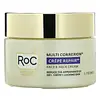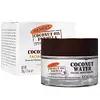What's inside
What's inside
 Key Ingredients
Key Ingredients

 Benefits
Benefits

 Concerns
Concerns

 Ingredients Side-by-side
Ingredients Side-by-side

Water
Skin ConditioningTriheptanoin
Skin ConditioningStearyl Alcohol
EmollientPrunus Amygdalus Dulcis Oil
Skin ConditioningPersea Gratissima Oil
Skin ConditioningPolyglyceryl-3 Methylglucose Distearate
EmulsifyingGlycerin
HumectantLinum Usitatissimum Seed Extract
PerfumingSodium PCA
HumectantPanthenol
Skin ConditioningSodium Hyaluronate
HumectantProline
Skin ConditioningHydroxyproline
Skin ConditioningCaprylhydroxamic Acid
1,2-Hexanediol
Skin ConditioningPropanediol
SolventCoco-Caprylate/Caprate
EmollientDilinoleic Acid
EmollientSimmondsia Chinensis Seed Extract
AbrasiveCaprylyl Glycol
EmollientButyrospermum Parkii Butter
Skin ConditioningDimethicone
EmollientDisodium EDTA
Stearic Acid
CleansingHexylresorcinol
AntimicrobialMacadamia Ternifolia Seed Oil
EmollientSimmondsia Chinensis Seed Oil
EmollientSea Water
HumectantGlyceryl Stearate
EmollientCarthamus Tinctorius Seed Oil
MaskingAstragalus Membranaceus Root Extract
EmollientUbiquinone
AntioxidantTocopherol
AntioxidantSpilanthes Acmella Flower/Leaf/Stem Extract
AntimicrobialXanthan Gum
EmulsifyingTocopheryl Acetate
AntioxidantParfum
MaskingCitric Acid
BufferingAminomethyl Propanol
BufferingWater, Triheptanoin, Stearyl Alcohol, Prunus Amygdalus Dulcis Oil, Persea Gratissima Oil, Polyglyceryl-3 Methylglucose Distearate, Glycerin, Linum Usitatissimum Seed Extract, Sodium PCA, Panthenol, Sodium Hyaluronate, Proline, Hydroxyproline, Caprylhydroxamic Acid, 1,2-Hexanediol, Propanediol, Coco-Caprylate/Caprate, Dilinoleic Acid, Simmondsia Chinensis Seed Extract, Caprylyl Glycol, Butyrospermum Parkii Butter, Dimethicone, Disodium EDTA, Stearic Acid, Hexylresorcinol, Macadamia Ternifolia Seed Oil, Simmondsia Chinensis Seed Oil, Sea Water, Glyceryl Stearate, Carthamus Tinctorius Seed Oil, Astragalus Membranaceus Root Extract, Ubiquinone, Tocopherol, Spilanthes Acmella Flower/Leaf/Stem Extract, Xanthan Gum, Tocopheryl Acetate, Parfum, Citric Acid, Aminomethyl Propanol
Water
Skin ConditioningCocos Nucifera Fruit Extract
EmollientCocos Nucifera Oil
MaskingLauryl Olivate
Sorbitan Olivate
EmulsifyingGlycerin
HumectantCocos Nucifera Water
MaskingSodium Hyaluronate
HumectantTocopherol
AntioxidantLactobacillus/Papaya Fruit Ferment Extract
AbrasiveGardenia Taitensis Flower Extract
Skin ConditioningOenothera Biennis Flower Extract
AstringentMacadamia Ternifolia Seed Oil
EmollientSimmondsia Chinensis Seed Oil
EmollientPrunus Amygdalus Dulcis Oil
Skin ConditioningPersea Gratissima Oil
Skin ConditioningTocopheryl Acetate
AntioxidantLeuconostoc/Radish Root Ferment Filtrate
AntimicrobialEthylhexylglycerin
Skin ConditioningTetrasodium EDTA
Sodium Hydroxide
BufferingAcrylates/C10-30 Alkyl Acrylate Crosspolymer
Emulsion StabilisingSodium Metabisulfite
AntioxidantSodium Sulfite
PreservativeParfum
MaskingPropylene Glycol
HumectantPhenoxyethanol
PreservativeCoumarin
PerfumingWater, Cocos Nucifera Fruit Extract, Cocos Nucifera Oil, Lauryl Olivate, Sorbitan Olivate, Glycerin, Cocos Nucifera Water, Sodium Hyaluronate, Tocopherol, Lactobacillus/Papaya Fruit Ferment Extract, Gardenia Taitensis Flower Extract, Oenothera Biennis Flower Extract, Macadamia Ternifolia Seed Oil, Simmondsia Chinensis Seed Oil, Prunus Amygdalus Dulcis Oil, Persea Gratissima Oil, Tocopheryl Acetate, Leuconostoc/Radish Root Ferment Filtrate, Ethylhexylglycerin, Tetrasodium EDTA, Sodium Hydroxide, Acrylates/C10-30 Alkyl Acrylate Crosspolymer, Sodium Metabisulfite, Sodium Sulfite, Parfum, Propylene Glycol, Phenoxyethanol, Coumarin
 Reviews
Reviews

Ingredients Explained
These ingredients are found in both products.
Ingredients higher up in an ingredient list are typically present in a larger amount.
Glycerin is already naturally found in your skin. It helps moisturize and protect your skin.
A study from 2016 found glycerin to be more effective as a humectant than AHAs and hyaluronic acid.
As a humectant, it helps the skin stay hydrated by pulling moisture to your skin. The low molecular weight of glycerin allows it to pull moisture into the deeper layers of your skin.
Hydrated skin improves your skin barrier; Your skin barrier helps protect against irritants and bacteria.
Glycerin has also been found to have antimicrobial and antiviral properties. Due to these properties, glycerin is often used in wound and burn treatments.
In cosmetics, glycerin is usually derived from plants such as soybean or palm. However, it can also be sourced from animals, such as tallow or animal fat.
This ingredient is organic, colorless, odorless, and non-toxic.
Glycerin is the name for this ingredient in American English. British English uses Glycerol/Glycerine.
Learn more about GlycerinMacadamia Ternifolia Seed Oil is the fixed oil obtained from Macadamia nut.
Macadamia seed oil is rich in fatty acids, including oleic acid (45-75%), palmitoleic acid (7-33%), and palmitic acid (6-12%). They also contain various B vitamins, iron, and magnesium.
Palmitoleic acid has been shown to help soothe inflammation and promote wound healing. It is also naturally found in the fat of our skin.
Macadamia seed oil may not be malassezia folliculitis, or fungal-acne, safe.
Learn more about Macadamia Ternifolia Seed OilParfum is a catch-all term for an ingredient or more that is used to give a scent to products.
Also called "fragrance", this ingredient can be a blend of hundreds of chemicals or plant oils. This means every product with "fragrance" or "parfum" in the ingredients list is a different mixture.
For instance, Habanolide is a proprietary trade name for a specific aroma chemical. When used as a fragrance ingredient in cosmetics, most aroma chemicals fall under the broad labeling category of “FRAGRANCE” or “PARFUM” according to EU and US regulations.
The term 'parfum' or 'fragrance' is not regulated in many countries. In many cases, it is up to the brand to define this term.
For instance, many brands choose to label themselves as "fragrance-free" because they are not using synthetic fragrances. However, their products may still contain ingredients such as essential oils that are considered a fragrance by INCI standards.
One example is Calendula flower extract. Calendula is an essential oil that still imparts a scent or 'fragrance'.
Depending on the blend, the ingredients in the mixture can cause allergies and sensitivities on the skin. Some ingredients that are known EU allergens include linalool and citronellol.
Parfum can also be used to mask or cover an unpleasant scent.
The bottom line is: not all fragrances/parfum/ingredients are created equally. If you are worried about fragrances, we recommend taking a closer look at an ingredient. And of course, we always recommend speaking with a professional.
Learn more about ParfumPersea Gratissima Oil is also known as avocado oil.
Avocado Oil has antioxidant properties. It is mostly made up of the glycerides of fatty acids. About 67% of these fatty acids is made up of oleic acid. Palmitic acid and linoleic acid are also present.
These fatty acids help hydrate and soften the skin. It may increase collagen content in the skin. Collagen helps keep your skin plump and firm. This ingredient helps reduce inflammation and has not shown to clog pores.
This ingredient may not be fungal-acne safe due to its high fatty acid content.
Avocados also have B vitamins, vitamin K, vitamin C, vitamin E, and potassium.
Learn more about Persea Gratissima OilPrunus Amygdalus Dulcis Oil comes from the sweet almond, a tree native to Iran. This oil has no fragrance and is non-volatile.
Almonds contain healthy fats, vitamins, and minerals. It is a rich source of Vitamin E, a great antioxidant and skin conditioning ingredient. Sweet almond oil contains fatty acids such as linolenic acid and triglycerides.
The content of sweet almond oil makes it a great emollient; it can help soften and hydrate your skin. Emollients create a barrier over your skin to trap moisture in. Sweet almond oil has antioxidant properties.
Those with an almond allergy should be careful of this ingredient and speak with a professional about using it in your skincare.
This ingredient may not be fungal-acne safe.
Learn more about Prunus Amygdalus Dulcis OilThis oil comes from the seeds of the desert shrub called Jojoba. It is more commonly known as jojoba oil, a non-comedogenic oil.
Jojoba oil does not contain fragrance and has many fatty-acids, making it a great soothing ingredient.
It also contains Vitamin E, a great moisturizing ingredient. Vitamin E is also an antioxidant and protects your skin against oxidative damage.
This ingredient humectant properties, meaning it helps draw moisture from the air. This helps keep your skin hydrated.
While jojoba has antibacterial properties, it is only able to kill some strains of bacteria.
Studies also show it helps in wound healing. In fact, Indigenous cultures have used jojoba as a moisturizer and to help treat burns for centuries.
Fun fact: Jojoba oil similar to natural human skin sebum, so it has a great effect on dry skin. It is also promising with helping to regulate sebum production.
Due to its fatty acid content, Jojoba oil may not be fungal acne safe. We recommend speaking with a professional if you have any concerns.
Learn more about Simmondsia Chinensis Seed OilSodium Hyaluronate is hyaluronic acid's salt form. It is commonly derived from the sodium salt of hyaluronic acid.
Like hyaluronic acid, it is great at holding water and acts as a humectant. This makes it a great skin hydrating ingredient.
Sodium Hyaluronate is naturally occurring in our bodies and is mostly found in eye fluid and joints.
These are some other common types of Hyaluronic Acid:
Learn more about Sodium HyaluronateTocopherol (also known as Vitamin E) is a common antioxidant used to help protect the skin from free-radicals and strengthen the skin barrier. It's also fat soluble - this means our skin is great at absorbing it.
Vitamin E also helps keep your natural skin lipids healthy. Your lipid skin barrier naturally consists of lipids, ceramides, and fatty acids. Vitamin E offers extra protection for your skin’s lipid barrier, keeping your skin healthy and nourished.
Another benefit is a bit of UV protection. Vitamin E helps reduce the damage caused by UVB rays. (It should not replace your sunscreen). Combining it with Vitamin C can decrease sunburned cells and hyperpigmentation after UV exposure.
You might have noticed Vitamin E + C often paired together. This is because it is great at stabilizing Vitamin C. Using the two together helps increase the effectiveness of both ingredients.
There are often claims that Vitamin E can reduce/prevent scarring, but these claims haven't been confirmed by scientific research.
Learn more about TocopherolTocopheryl Acetate is AKA Vitamin E. It is an antioxidant and protects your skin from free radicals. Free radicals damage the skin by breaking down collagen.
One study found using Tocopheryl Acetate with Vitamin C decreased the number of sunburned cells.
Tocopheryl Acetate is commonly found in both skincare and dietary supplements.
Learn more about Tocopheryl AcetateWater. It's the most common cosmetic ingredient of all. You'll usually see it at the top of ingredient lists, meaning that it makes up the largest part of the product.
So why is it so popular? Water most often acts as a solvent - this means that it helps dissolve other ingredients into the formulation.
You'll also recognize water as that liquid we all need to stay alive. If you see this, drink a glass of water. Stay hydrated!
Learn more about Water